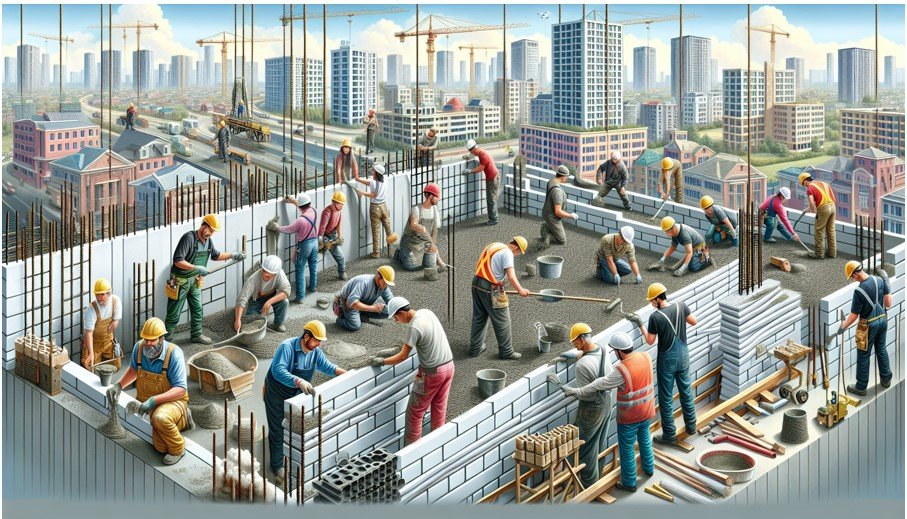Concrete Rendering vs. Insulation Render: Which Option Is Right for Your Project?
When it comes to protecting and enhancing the exterior of your building, two popular options are concrete rendering and insulation render. Both techniques offer unique benefits and can significantly improve the appearance and durability of your structure. In this comprehensive guide, we will explore the differences between concrete rendering and insulation render, helping you determine which option is best suited for your project.
What is Concrete Rendering?
Concrete rendering is a process that involves applying a mixture of cement, sand, and water to the exterior walls of a building. This mixture is applied in layers, creating a smooth and uniform surface that can be painted or left as is. Concrete rendering is a popular choice for both residential and commercial buildings, as it provides a durable and long-lasting finish.
Benefits of Concrete Rendering
- Durability: Concrete rendering is highly resistant to weathering, cracking, and chipping, making it an ideal choice for buildings exposed to harsh environmental conditions.
- Aesthetics: Concrete rendering can be customised to achieve a variety of textures and finishes, allowing you to create a unique and attractive exterior for your building.
- Low Maintenance: Once applied, concrete rendering requires minimal maintenance, saving you time and money in the long run.
Drawbacks of Concrete Rendering
- Limited Insulation: Concrete rendering does not provide significant insulation benefits, which can lead to higher energy costs and reduced comfort levels within the building.
- Moisture Retention: If not properly sealed, concrete rendering can absorb moisture, leading to dampness and potential mould growth.
What is Insulation Render?
Insulation render, also known as external wall insulation (EWI), is a technique that involves applying a layer of insulation material, such as expanded polystyrene (EPS) or mineral wool, to the exterior walls of a building. This insulation layer is then covered with a protective render, creating a seamless and energy-efficient exterior.
Benefits of Insulation Render
- Energy Efficiency: Insulation render significantly reduces heat loss through the walls, resulting in lower energy bills and a more comfortable indoor environment.
- Moisture Resistance: The protective render layer helps prevent moisture from penetrating the insulation, minimising the risk of dampness and mould growth.
- Soundproofing: Insulation render can help reduce external noise, creating a more peaceful and quiet interior space.
Drawbacks of Insulation Render
- Higher Initial Cost: Insulation render is generally more expensive than concrete rendering due to the additional materials and labour required.
- Thickness: The insulation layer can add significant thickness to the walls, which may require adjustments to window and door frames.
Factors to Consider When Choosing Between Concrete Rendering and Insulation Render
Climate
The climate in which your building is located should be a key consideration when deciding between concrete rendering and insulation render. In colder regions, insulation render may be the better choice, as it helps retain heat and reduce energy costs. In warmer climates, concrete rendering may be sufficient, as insulation is less of a concern.
Building Type and Age
The type and age of your building can also influence your decision. For older buildings with solid walls, insulation render can be an effective way to improve energy efficiency without the need for costly and disruptive internal insulation. For newer buildings with cavity walls, concrete rendering may be a more suitable option, as the cavity insulation already provides a degree of thermal protection.
Budget
Your available budget will also play a role in determining which option is best for your project. While insulation render offers long-term energy savings, it does require a higher initial investment compared to concrete rendering. If you have a limited budget, concrete rendering may be the more feasible choice.
Aesthetics
Both concrete rendering and insulation render offer a range of aesthetic options, from smooth and modern finishes to more traditional and textured appearances. Consider the style of your building and the surrounding environment when making your decision, as this can help ensure a cohesive and attractive result.
The Concrete Rendering Process
Surface Preparation
Before applying concrete render, the surface of the building must be properly prepared. This involves cleaning the walls to remove any dirt, debris, or loose material, and repairing any cracks or damage. A primer may also be applied to improve adhesion and reduce the risk of cracking.
Mixing and Application
The concrete render mixture is typically composed of cement, sand, and water, with additives such as plasticizers and bonding agents sometimes included to improve performance. The mixture is thoroughly combined using a mechanical mixer until a smooth and consistent texture is achieved.
The render is then applied to the walls using a trowel or spray machine, starting at the bottom and working upwards. Multiple layers may be applied, with each layer being allowed to dry before the next is added. The final layer is often textured or smoothed to achieve the desired finish.
Curing and Finishing
After application, the concrete render must be allowed to cure properly to achieve its full strength and durability. This typically involves keeping the surface moist for several days to prevent rapid drying and cracking. Once cured, the render can be painted or sealed as desired to protect it from the elements and enhance its appearance.
The Insulation Render Process
Insulation Board Installation
The first step in the insulation render process is to install the insulation boards onto the exterior walls of the building. The boards are typically made from expanded polystyrene (EPS) or mineral wool and are fixed to the walls using adhesive and mechanical fixings.
The boards are carefully positioned to ensure a tight fit, with any gaps or joints filled with expanding foam to prevent thermal bridging. The surface of the insulation boards is then sanded or rasped to create a smooth and even surface for the render application.
Base Coat and Reinforcement Mesh
Once the insulation boards are in place, a base coat of render is applied to the surface. This coat is typically a flexible, cement-based mixture that helps to bond the insulation to the render layers.
While the base coat is still wet, a reinforcement mesh is embedded into the surface. This mesh, usually made from fibreglass, helps to strengthen the render and prevent cracking. The mesh is carefully positioned to ensure complete coverage and overlap at the edges.
Finish Coat
After the base coat and reinforcement mesh have dried, a finish coat of render is applied. This coat is typically a thin, cement-based mixture that provides the final texture and color to the surface. The finish coat can be smooth, textured, or patterned, depending on the desired aesthetic.
The finish coat is applied using a trowel or spray machine, with care taken to achieve a consistent thickness and appearance across the entire surface. Once applied, the render is allowed to dry and cure fully before any final treatments, such as painting or sealing, are undertaken.
Maintenance and Repair
Both concrete rendering and insulation render require regular maintenance to ensure their longevity and performance. This may involve cleaning the surface to remove dirt and stains, repairing any cracks or damage that may occur, and reapplying protective coatings as needed.
For concrete rendering, maintenance typically involves:
- Regular cleaning with a mild detergent and water to remove dirt and stains
- Repairing any cracks or damage with a suitable filler or patching compound
- Reapplying paint or sealant as needed to protect the surface from the elements
For insulation render, maintenance may include:
- Cleaning the surface with a soft brush or low-pressure washer to remove dirt and debris
- Checking for any cracks or damage and repairing them promptly to prevent water infiltration
- Reapplying a protective top coat every 5-10 years, depending on the specific system and environmental conditions
Regular maintenance can help to extend the lifespan of both concrete rendering and insulation render, ensuring that your building remains protected and attractive for years to come.
Conclusion
Choosing between concrete rendering and insulation render for your project depends on a variety of factors, including climate, building type and age, budget, and desired aesthetics. While concrete rendering offers durability and versatility, insulation render provides superior energy efficiency and moisture resistance.
Ultimately, the best choice for your project will depend on your specific needs and priorities. By carefully considering the benefits and drawbacks of each option, and consulting with experienced professionals, you can make an informed decision that will provide long-lasting protection and performance for your building.
Whether you choose concrete rendering or insulation render, proper installation and regular maintenance are essential to ensuring the best possible results. By following best practices and working with skilled contractors, you can achieve a high-quality, attractive, and durable exterior for your building that will stand the test of time.














Post Comment